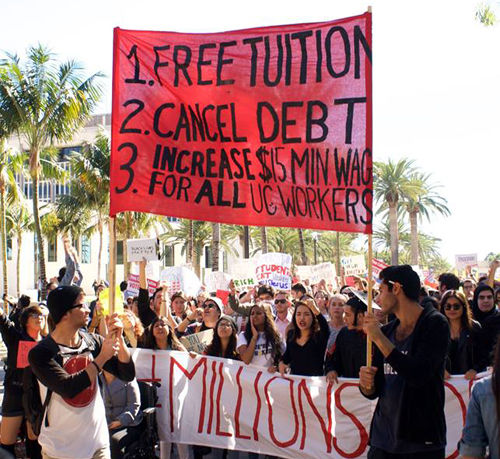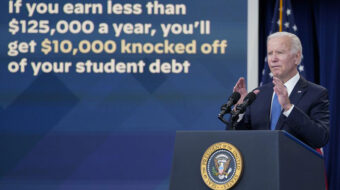
CHICAGO — It’s been a powerful week for students, young people and underpaid workers. But the Mizzou protesters, the Fight for $15 Day of Action and the #MillionStudentMarch are being brutally attacked on conservative news and on social media.
The #MillionStudentMarch took place on Nov. 12 in over 100 cities across the nation protesting the rising cost of college and wage stagnation that has resulted in $1.2 trillion in American student debt. The protesters demanded free public university education, cancellation of all outstanding student debt, and a $15 an hour minimum wage for campus workers.
The #MillionStudentMarch is also a demand to end federal and local cuts to educational institutions – along with the exorbitant salaries for University Presidents, administrators and football coaches – that drive up the cost of education for students. They also hope to impact the high interest rates on federal student loans, which are set by Congress and are currently a full percentage point above the interest rates set by the free market.
Bernie Sanders was the inspiration behind the #MillionStudentMarch; and during the debates on Saturday he stood by his commitment to raising the minimum wage to “fifteen bucks an hour” and making college tuition-free.
Answers to a question raised by opponents to the march (Who will pay for everybody’s free college?) have come under scrutiny, and Sanders, answered the very same question during the debate.
“I pay for my program,” Sanders explained, “through a tax on Wall Street speculation, which will not only make public colleges and universities tuition-free, it will substantially lower interest rates on college debt,” which he called “a major crisis in this country.”
On Sen. Sanders’ website, he lists the top ten corporations avoiding taxes.
Anybody with a calculator and the ability to read can figure out the next sentence: Our government can find trillions of dollars to help corporations profit, but when it comes to eradicating the student debt, all of a sudden there’s not enough money to go around.
According to Sanders’ site, huge corporations like General Electric, Boeing, Phizer, and FedEx, despite immense profits, pay a negative tax rate. Not only are they avoiding their tax responsibility as corporations by hoarding money in the Cayman Islands, but they are robbing the American people by seeking gigantic tax refunds and government bailouts.
Bank of America, coincidentally one of America’s biggest lenders of private student loans, received a bailout that could pay all of our outstanding student debt (with $100 billion left-over for, well, a pizza party or something). BOA would “owe an estimated $4.3 billion in federal income taxes if its use of offshore tax avoidance strategies were eliminated,” according to the Sanders’ site.
How much college could $4.3 billion pay for? And why is it that Republicans can magically find the money for Bank of America’s $1.9 billion tax refund, despite huge yearly profits, but when it comes to giving our citizens a fair and free public education, the coffers are lined with nothing more than mothballs?
A lot of criticism of the #MillionStudentMarch has also come from the “work hard and pay for your schooling, like I did“ camp. There are some issues with this logic, though. Not only has the cost of college risen over 500 percent since 1982 (meaning a tuition bill of $10,000 in ’82 would be more in the $24,000-range today), but the minimum wage hasn’t kept up with inflation.
Moreover, 80 percent of campus workers are not even being paid the minimum wage as defined by their city or state. In Chicago the minimum wage is $10 an hour but many student workers in the city make the federal minimum wage of $7.25, according to Ryan Watson, one of the #MillionStudentMarch organizers in Chicago.
At 40 hours per week, a worker making the federal minimum wage would make less than $300 a week, or about $15,000 a year; which is not even enough to pay living expenses (on average $10,000 per academic year, which doesn’t include the 3 months of summer, for on-campus room and board at a state school), let alone tuition (anywhere from $9,000 per year for in-state tuition to well over $30,000 per year for private and out-of-state collegiate tuition and fees).
So even though the average student worker makes about $15,000 per year, tuition, room and board are more like $20,000 a year…and we haven’t even been to the bookstore yet. These real numbers call into question critics’ claim that student marchers can simply work while attending school in lieu of borrowing for tuition payments.
More and more jobs require a college degree (nearly 60 percent, a number that has doubled since the early 1980s). The prevailing wisdom in America is that underpaid workers should achieve education in order to “get ahead” and score a job with a living wage and benefits. But it is impossible to obtain that education without taking on a debt so crippling that repayment is impossible.
Degreed workers end up still making low wages: If $15 is a fair minimum hourly wage, how much should college educated folks be making in the job place? With a 16.8 percent underemployment rate, it is apparent that an education does not guarantee you a fair wage or job security.
The paradox of American education says: “Get an education to make more money, have a more rewarding and relaxing life, and achieve the American dream.” But it is impossible to obtain an education without crippling debt that leaves those who do make a decent wage in poverty after monthly loan payments. So, stay poor and be able to defer payments indefinitely or make a living wage and still live in poverty because loan payments are so high. All while Wells Fargo, Navient, and BOA are making millions exploiting America’s young people.












Comments